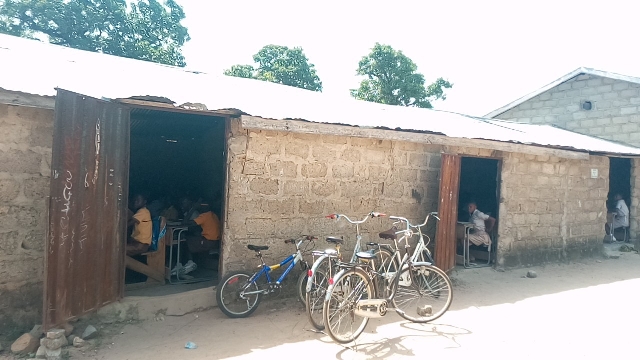UE/R: Bolgatanga hanging schools bedeviling quality education
 The poor state of these educational facilities in the Bolgatanga Municipality has raised questions about the commitment to ensuring quality education for all children
The poor state of these educational facilities in the Bolgatanga Municipality has raised questions about the commitment to ensuring quality education for all children
Poor infrastructure continues to bedevil access to quality education in various public basic schools in the Bolgatanga Municipality of the Upper East Region.
The unfortunate situation has turned many classrooms into potential death traps, putting the lives of young students at risk.
Pius Ayorogo is a 14-year-old Junior High School 3 student who dreams of becoming a pilot. He knows that this dream needs serious commitment and that he would need to study in a good educational facility, one that is equipped with computers.
But the 14-year-old attends a school without a proper structure.
“I want to be a pilot. But at my school, we don't have computers, I don't know how to create a folder. One of our teachers used to bring his laptop in primary six but I have never seen a computer,” he said.
Soe-Yipala Junior High School which was established in 2019, does not have its own structure.
The school is currently run in a community health facility with 57 students. An OPD and two rooms at the health facility are used as classrooms even if health staff are attending to patients.
Ayamga Gift, a classmate of Pius’ also indicated the challenges confronting them in the school.
“The classrooms are too small. We sit at three per desk and there is no space for the teacher to walk around and teach us. No water to drink when we are thirsty,” Gift said.
Co-curricular has never been on their calendar, Pius said. Additionally, the school lacks the resources to afford football jerseys.
“Since form 1 till now, we have never played football. We don't have football jerseys, no balls, or anything related to sporting activity. It is sad,” he lamented.
In 2022, the school was ranked 20th in the BECE in the Bolgatanga Municipality despite its challenges. This success prompted community members to initiate a community mobilisation project to build a three-unit classroom block for the pupils.
When the construction reached the roofing stage, it was put on hold due to lack of funds. Numerous appeals were made to various stakeholders for support, but these appeals did not yield results.
Commenting on the issue, the Assembly member of the area, Abambire Augustine, said the very day that he heard about the school operating under the community health facility, he was shocked.
“I'm aware of the situation. I can tell you that I'm not sleeping on it. I have made several appeals to stakeholders regarding this matter and I pray things get better. The school exists without a structure and it is bad for our wards. I was shocked myself the very day that I heard of it,” he said.
He added that the Municipal Chief Executive of the area has promised to channel the needed development resources to the school.
There are 169 public basic schools in the Bolgatanga Municipality, 60 nursery schools, 57 primary schools, and 52 Junior High schools. Of this number, 25 operate under trees and 35 of them are conducive enough to improve teaching and learning.
The rest have either crumbling walls, broken doors and windows, or uncompleted structures. This situation has turned many classrooms into potential death traps, putting the lives of young students at risk.
Atolisum Junior High School in Kulbia, a suburb of Sumburungu in the Bolgatanga Municipality is an example of a death trap. Each classroom has nearly 34 students and measures 10 by 10 square feet instead of the usual measurement of 24 by 24 square feet.
Abigail Amoliga, a student also doubts if her dream of becoming a professional nurse will ever be achieved.
“Now, I don’t even know my fate because this harmattan season it is always difficult to sit and learn in the classroom. The teachers often find it difficult to stay for long to teach us. So, it's terrible, to say the least.”
The poor condition of the school has led many pupils to drop out while others are trying to seek transfer to other schools. Like David Abanga, one of the brilliant students at Atolisum Junior High School who sought transfer to Saint Charles Junior High School for a better learning environment.
According to David, he is happy at his new school and only hopes things will change for his old friends at Atolisum Junior High School.
“I’m happy at my new school though things are not all that good here, it is better than my former school. I hope things can change for them, especially my old friends there. The school building was terrible. It is part of the reason I sought to transfer here,” he explained.
Atolisum JHS currently has 92 students, but school authorities say this number could reduce in the next academic year due to poor infrastructure. Although the authorities of the school declined to speak on record, they indicated that the student population was close to 130, for the last academic year, but parents continue to seek transfers for their wards.
Many teachers have recently refused to be posted to the school. The school now struggles to attract students and teachers as it needs ICT, Religious and Moral Education, and Social Studies teachers.
The Saint Peter and Paul Basic School in the Atulbabisi community is another school that has struggled for many years to provide a conducive learning environment for its students.
Built by missionaries in the 19th century, the school once had an enrolment of about 350 pupils but this has reduced to 138 pupils due to its uncompleted nature, broken doors and windows, and the lack of additional classroom blocks.
Of course, school authorities refused to speak. The Assembly member for the area, Aaron Abongo, however, indicated that the situation needs an urgent solution.
According to him, he has not been sleeping over the issue and will continue to let stakeholders that matter know the current situation and come to the aid of the pupils.
“If I should tell you the number of people who have attended this school and are now better people in society you won't believe it. It is really sad when I see these little ones sitting in this dilapidated structure to study. I must say that I have approached the municipal chief executive on it and assurance has been given. I only pray that it comes to reality,” the assembly member said.
Also, at the Dorongo Kindergarten and Zaare Preparatory Primary School, the stories are the same. The schools need serious attention from the government and stakeholders.
The poor state of these educational facilities in the Bolgatanga Municipality has raised questions about the commitment to ensuring quality education for all children, regardless of where they live. It has also raised questions of whether Goal 4 of the Sustainable Development Goals which seeks to ensure inclusive and equitable access to quality education for all, can be achieved by 2030.
Speaking on the issue, the Municipal Chief Executive, Rex Asanga explained that the Assembly has never been quiet on the matter as major efforts have been made to renovate identifiable school structures.
“I have never relented on these issues. Quality education is key and I'm doing everything within my power to fix the issue of schools under trees. Some of these schools will see some renovation this year,” Asanga said.
These particular schools, Mr Asanga said have been marked to see some facelift.
“These five basic schools that you have mentioned have come to my notice and I have visited them to see all that is going on. We have put some budget on that, especially under our SOCO project-education is our priority. We are on course to provide quality education for our children at the basic level in this municipality,” he added.
Meanwhile, the Bolgatanga Municipal Directorate of the Ghana Education Service would not comment on the matter. The Director in charge of the Directorate, Madam Estella Ann, said she needs approval from the Regional Directorate before she can comment on the matter.
The future of these young people and the quality of education in the Municipality are at stake, and urgent action is needed to address this issue comprehensively and decisively.
Source: classfmonline.com/Moses Apiah
Trending News

Ashanti NDC members protest return of former DVLA regional director
14:24
Ghana revokes diplomatic and service passports of former officials and non-state actors
13:12
MP for Awutu Senya West supports 53 tertiary students with scholarships
11:49
Defence Minister commends Erastus Asare Donkor for anti-galamsey reporting
01:03
DVLA to open six overseas offices to help curb fake Ghanaian licences abroad
11:54
Supreme Court dismisses injunction application against President Mahama in Chief Justice case
12:41
GA/R: Tragic fire claims life of 5-year-old girl at Adjei Kojo Sancity
11:36
National Chairman is attending to some urgent issues in Accra, he will join the tour after that - Justin Kodua
00:19
COCOBOD CEO urges return to core mandate of funding cocoa
11:28
Sam George throws shade at Afenyo-Markin over police assault claims
12:21



